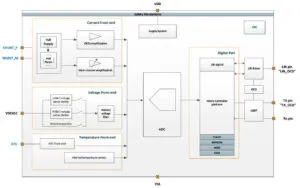- MLX91230KDC-BBC-200-RE is a ±512mT Hall-based sensor and comes in an SOIC8
- MLX91231KGO-BBC-000-RE is a -100mV to +256mV shunt sensor and comes in a TSSOP16
“The integration of the NTC input into the MLX91230 and MLX91231 sensors improves the detection of variations in system temperatures. For the shunt interface MLX91231 in particular, it offers [information to] compensate the shunt resistor’s residual variability over temperature,” according to the company. “Furthermore, the NTC input is ASIL C compliant, allowing for deployment in safety-critical automotive applications, including automotive batteries, dc fast charging, smart pyro-fuses and power distribution modules.”
While they have different current sensors, both chips have three measurement modes for there voltage input pin:
- 0.3 to 1.1V with high input impedance for connecting to an external divider.
- 3 to 18V (for 12V batteries) drawing 30μA due to the internal divider.
- 20 to 60V (for 24 and 48V batteries) drawing 110μA.
The NTC (negative temperature coefficient) thermistor input works with external values from 500Ω to 500kΩ, with the 10kΩ Murata NCU18XH103F6SRB suggested in the data sheet.
“ASIL C functional safety compliance to ISO 26262 applies to the current, voltage, and external NTC measurement, as well as the diagnosable over-current detection – over-current detection also permits direct input to [a] pyro-fuse driver,” said the company.
Internal die temperature is also available, and is also available in other variants of the MLX91230 and MLX91231 which do not have NTC inputs.
The internal microcontroller provides data in LIN or UART format through separate pins, which can also hact ad hardware over-current warning outputs.
Custom software can be developed for the internal MCU.
The Melexis web pages to the product can be found through these links: MLX91230 (Hall) and MLX91231 (shunt).

